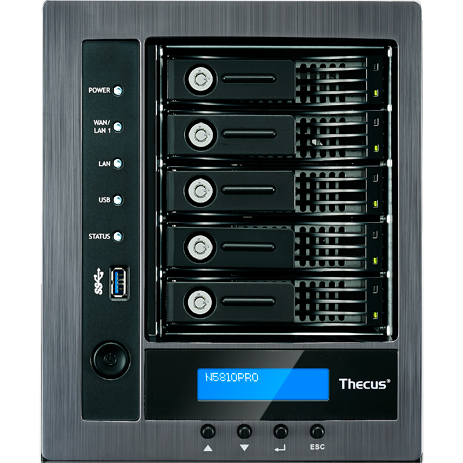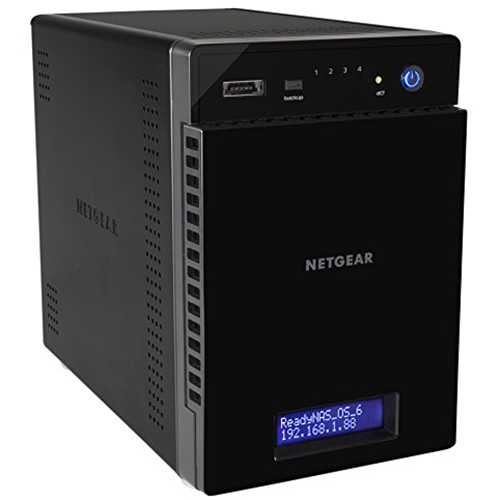QNAP TS-451+ NAS Review
Why you can trust Tom's Hardware
Four-Corner Performance Testing
We've updated our comparison units now that we have a sufficient number of mid-range models in the database. In the coming months, we'll publish reviews of Asustor's AS6104T and Netgear's ReadyNAS 214. You can read our review of the Thecus N5810 Pro here.
All of the systems in today's review are filled with Seagate NAS 4TB disks in RAID 5, and they run from a single GbE port through an enterprise switch.
Sequential Data Transfer by Block Size
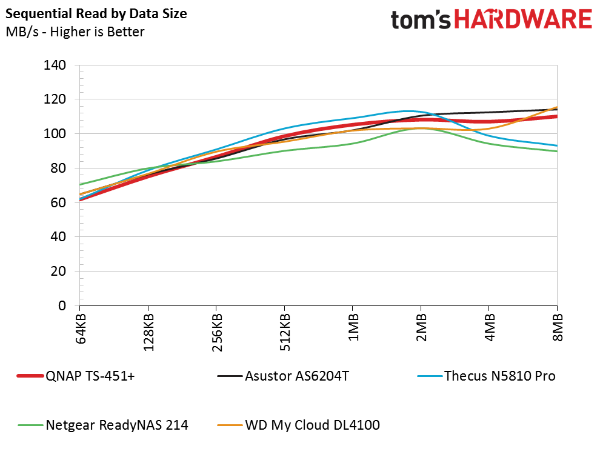
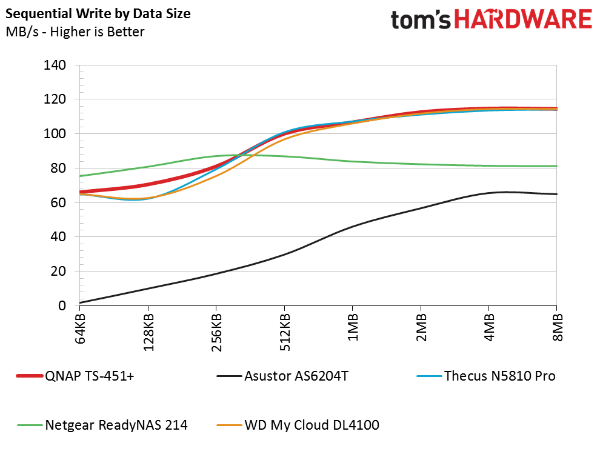
The sequential read performance for every system is similar at each block size. This isn't a very stressful metric, but it does give us some idea of what to look for as our testing continues.
There's a lot more variation in the sequential write test. Asustor's AS6204T is on the first iteration of the company's newest operating system, and it clearly has some issues with smaller block sizes. The TS-451+ finishes without encountering any issues; it performs particularly well in the 64KB and 128KB tests, posting bigger numbers than Thecus and Western Digital.
Sequential Performance
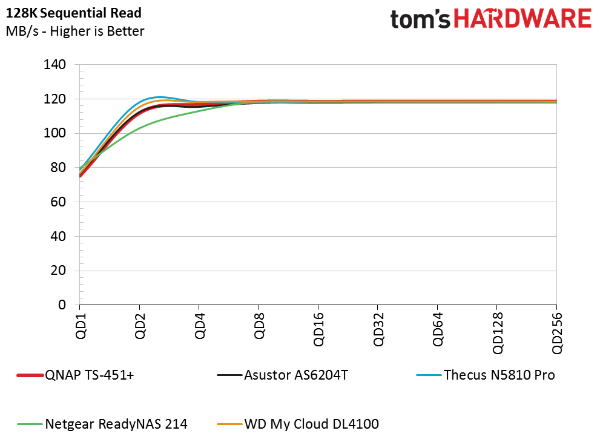
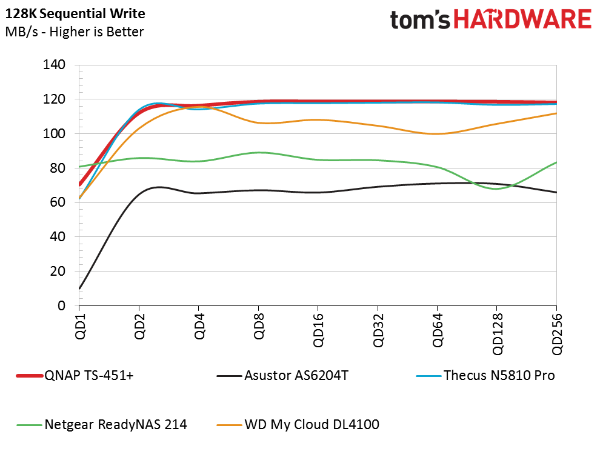
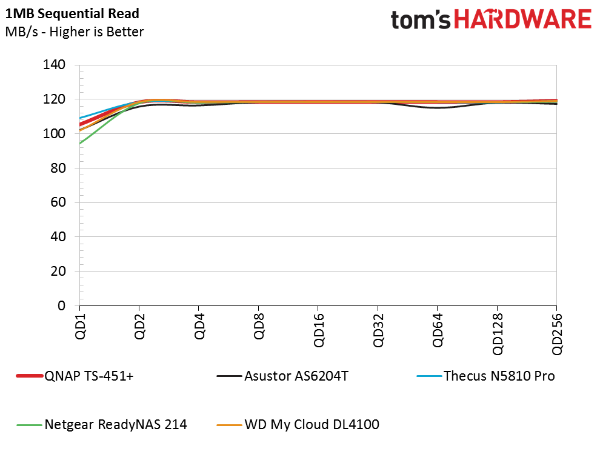
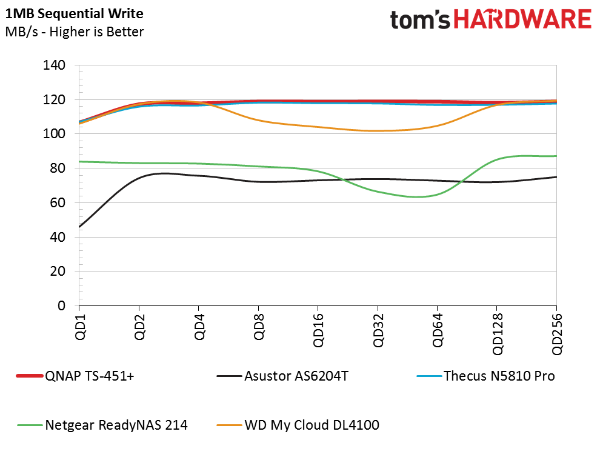
Now we're looking at 128KB and 1MB blocks, charted across increasing queue depths. Interestingly, the mid-range systems we're measuring don't report higher throughput as queue depths go up. That would normally be bad. But many of these platforms saturate a GbE link at low queue depths, so that's our bottleneck.
The write tests again yield a wider range of performance results. QNAP's TS-451+ performs well, managing to saturate the gigabit Ethernet connection.
Sequential Mixed Data Sweep
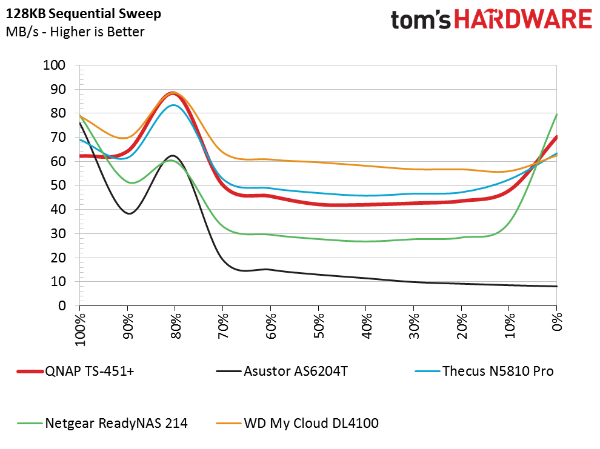
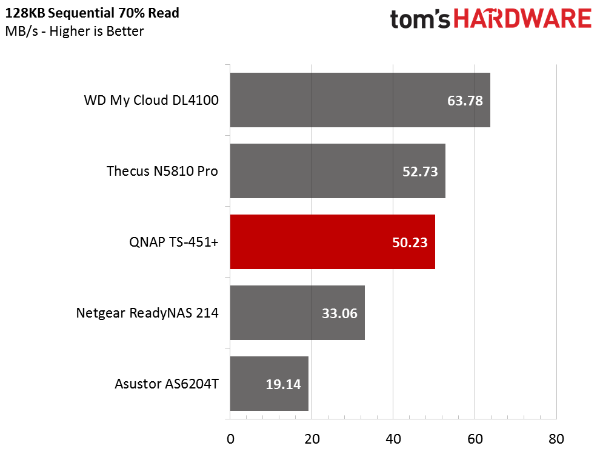
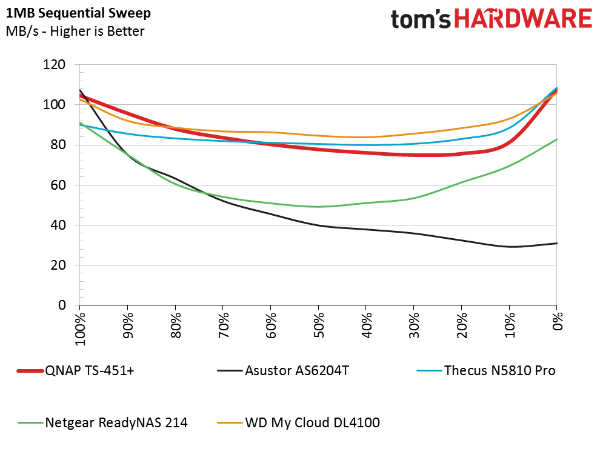
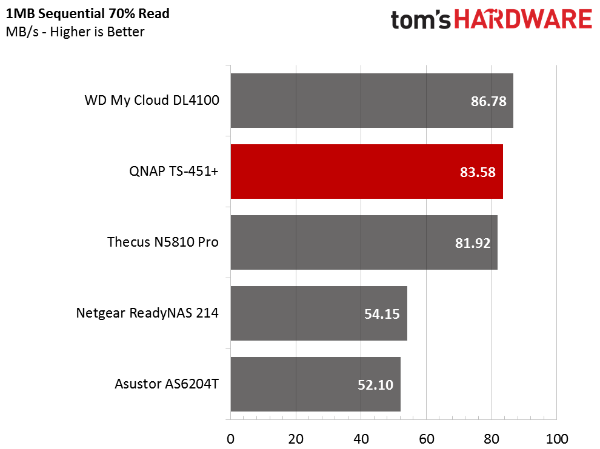
All of the systems are optimized for workloads consisting of 80 percent reads. Back when the SSD 520 launched, Intel published a document claiming that 80 percent reads are typical for most client systems. Seventy percent reads are more common among workstations.
The bathtub curve observed here is what we're accustomed to. After all, mixing reads and writes presents a greater challenge than a pure read or pure write workload.
Random Data Transfer by Size
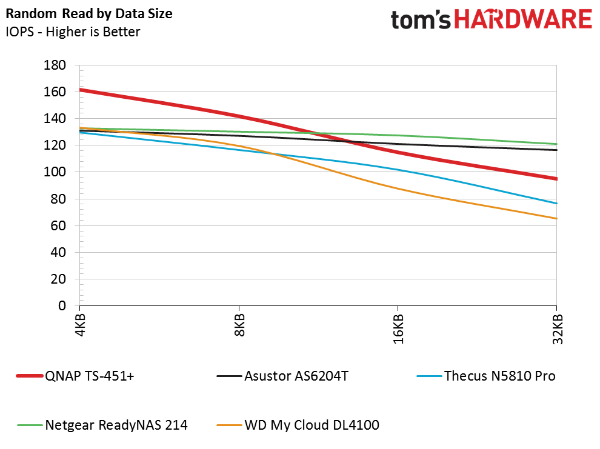
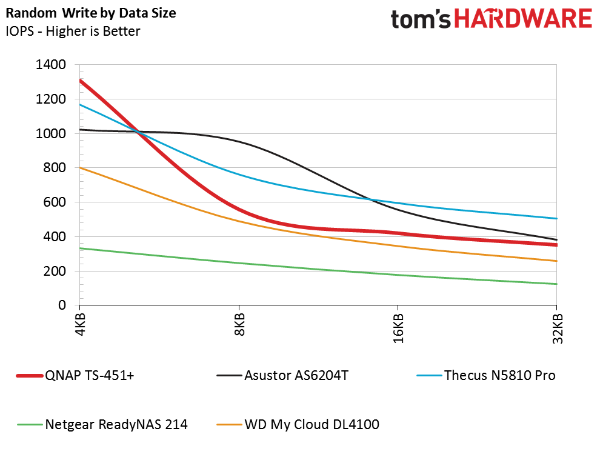
For the most part, if you don't run applications on the NAS or use the appliance as an active disk with a mapped volume, you will rarely transfer files in a random manner. Even when you send small blocks of data over SMB, the information moves sequentially. Hosting an app on the NAS is another story entirely, though.
In both the read and write tests, QNAP's TS-451+ outperforms its competition in random 4KB performance. This is important for running applications with Windows, where 4KB blocks make up a majority of the workload. The 8KB block size is often associated with virtual machines from VMWare. The TS-451+ also outperforms the other products there, though it falls behind two systems in 8KB random writes.
Random Performance
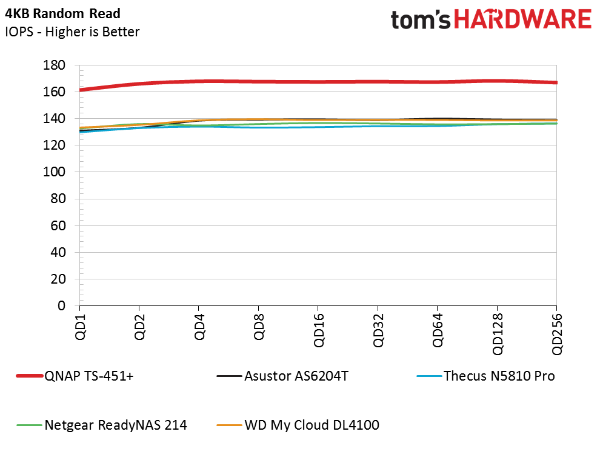
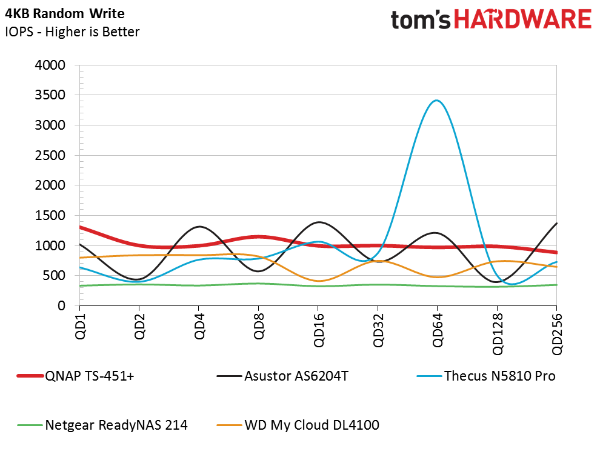
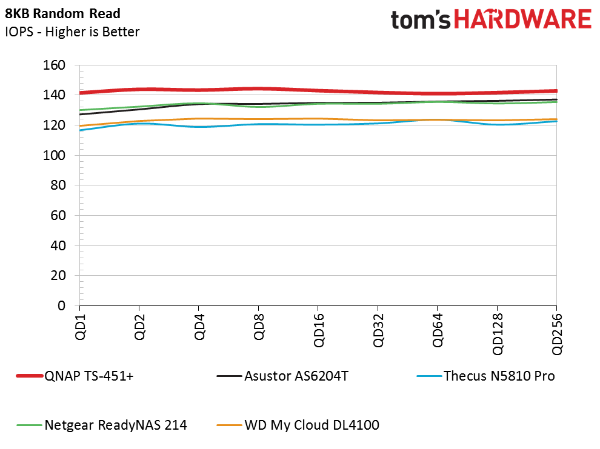
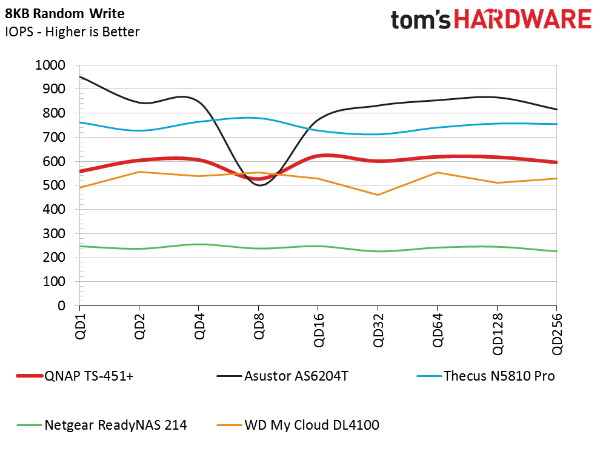
Ratcheting up the random workload by scaling queue depth doesn't do much for performance. For the most part, these systems demonstrate fairly linear performance as the queue depth increases.
Random Mixed Data Sweep
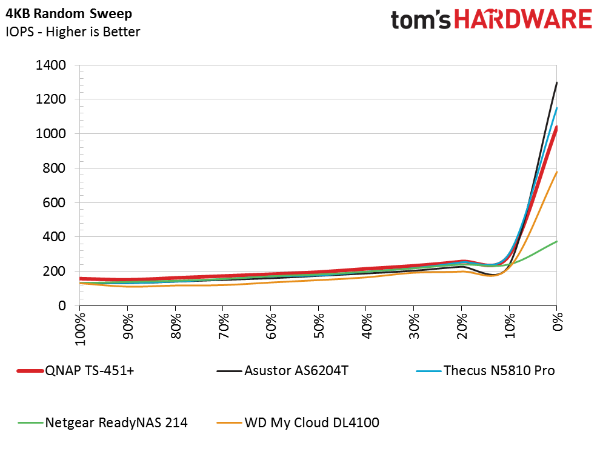
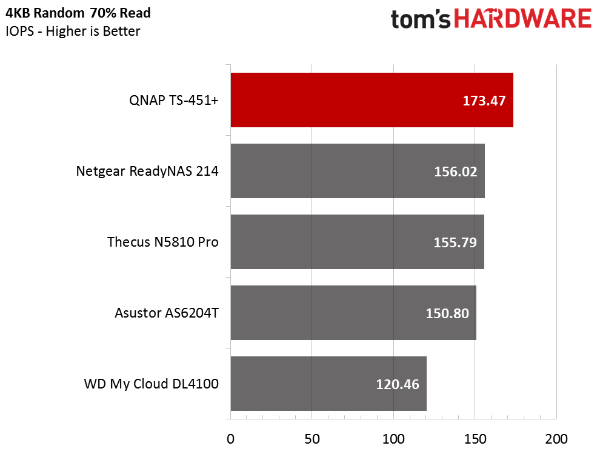
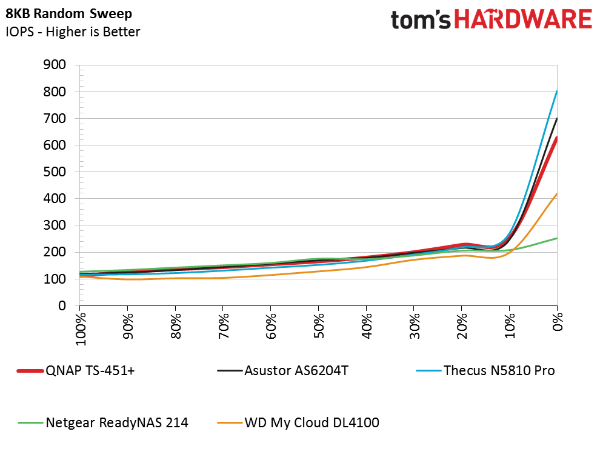
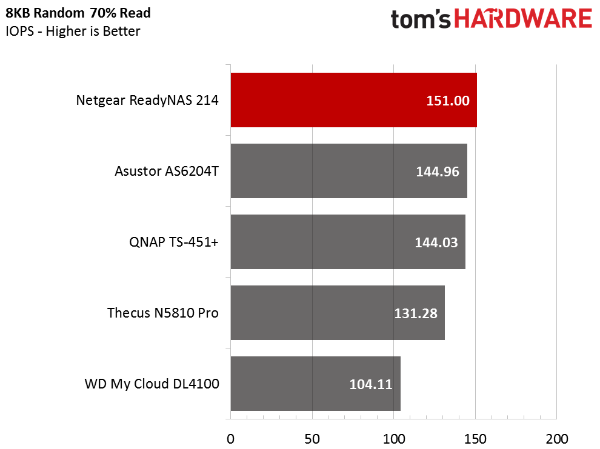
Under heavy random writes, all of the systems use cache algorithms to burst performance. None of them exhibit a bathtub curve as we sweep across the mixed workloads. We see very little variation until the test's end, where caching performance differentiates each appliance.
Current page: Four-Corner Performance Testing
Prev Page Software Next Page SMB, iSCSI And Standard Server WorkloadsStay On the Cutting Edge: Get the Tom's Hardware Newsletter
Get Tom's Hardware's best news and in-depth reviews, straight to your inbox.
-
RedJaron ReplyThis is the new breed of network-attached devices that extends beyond storage. Many new home and small office QNAP systems fall into this category. Nobody has coined an official term for these systems, but someone really should. Continuing to call them NAS fails to capture everything they're capable of.
Hmmm, well first, the problem is that NAS on its own was a bit of a misnomer in a lot of cases. The idea of "Network Attached Storage" is just talking about the storage itself, the drives, not the machine that actually hosts or manages them. It works fine for describing an external hard drive plugged into a router over USB, but any time you have a dedicated device for hosting and managing a storage array, the idea of NAS alone was no longer sufficient for it. Even if it didn't have the media abilities this one did, if it had its own OS, if you could remote into to and configure the storage system, if it was more or less autonomous, that's more a server than just NAS array.
NAS Server, or NASS is probably too similar and would be confusing. Network Attached Managed Storage or Networked Attached Hosted Storage would be more accurate, though "hosted" has cloud storage connotations so that may not be great. You could call them NARCs for network attached RAID controllers/computers. But in reality these things are servers. A Celeron is far beyond a simple hard drive or RAID controller and QNAP's OS is far beyond a simple router firmware. These are network storage servers, or simple network storage servers if you want to differentiate them from from the big, expensive server clusters. If you want to keep it close to NAS, I'd call it a NARS ( network attached RAID server ). -
blazorthon ReplyHmmm, well first, the problem is that NAS on its own was a bit of a misnomer in a lot of cases. The idea of "Network Attached Storage" is just talking about the storage itself, the drives, not the machine that actually hosts or manages them. It works fine for describing an external hard drive plugged into a router over USB, but any time you have a dedicated device for hosting and managing a storage array, the idea of NAS alone was no longer sufficient for it. Even if it didn't have the media abilities this one did, if it had its own OS, if you could remote into to and configure the storage system, if it was more or less autonomous, that's more a server than just NAS array.
NAS Server, or NASS is probably too similar and would be confusing. Network Attached Managed Storage or Networked Attached Hosted Storage would be more accurate, though "hosted" has cloud storage connotations so that may not be great. You could call them NARCs for network attached RAID controllers/computers. But in reality these things are servers. A Celeron is far beyond a simple hard drive or RAID controller and QNAP's OS is far beyond a simple router firmware. These are network storage servers, or simple network storage servers if you want to differentiate them from from the big, expensive server clusters. If you want to keep it close to NAS, I'd call it a NARS ( network attached RAID server ).
NARC has my vote. -
palladin9479 ReplyThis is the new breed of network-attached devices that extends beyond storage. Many new home and small office QNAP systems fall into this category. Nobody has coined an official term for these systems, but someone really should. Continuing to call them NAS fails to capture everything they're capable of.
We do have a name for it. It's a very old name with a distinguished history, it's known as "File Server". This is no different then having Unix / Linux / NT installed on a server and then exporting storage to a local network in whatever language / protocol is necessary. Hiding the OS from the customer nor automating the maintenance of the File Server does not change it's designation or purpose. Further if we wanted to install additional services onto our File Server it now becomes an Application Server and since it's an All-In-One device we could just call it a Server. Congratulations on reinventing a 1980's concept.
As for iSCSI in a home environment, just say no. There is a reason it's not used. Without jumbo frames, and a dedicated VLAN / QoS you are going to be shredding your network I/O. Each 4K I/O block gets broken into three separate Ethernet frames and blasted out across the switch where it competes with every other form of traffic for bandwidth and network I/O. It's heard by the distant end, reassembled in the network buffer, read and then another request is sent out, all without compression or any form of traffic shaping. It's perfectly fine for lab and experimental work but absolutely atrocious for real world work loads. If you have to store and execute data remotely then use SMB via a mounted drive letter or even a NTFS junction via mklink.
mklink /d C:\FolderToInstallStuff \\NASServer\\SMBShareFolder
Will create an entry in the NTFS file table that looks like a folder to everything, except the file storage subsystem, any file operations directed to that folder will instead be redirected to the remote SMB server. Applications will act exactly the same but without having to deal with the issues of having to abstract a block level device over a home network connection. Let the OS do it's job with optimizing network file I/O.
Side note about performance. The real difference between file level and block level access is where the onus of file system management takes place. With file level the remote file server is responsible and must spend CPU cycles and memory for caching the data, on block level your local machine is responsible for doing it. Since local machines tend to have more CPU / memory iSCSI would win in a back-to-back configuration (Client <-> Server) with nothing else happening on the switch, in which case might as well use a cross-over cable. The moment you start placing additional traffic on the network that the iSCSI packets now need to compete with, this starts to change as iSCSI wasn't designed to fight with other traffic nor is the client computer even aware that it has to. Also once your iSCSI storage manager has enough CPU power and memory to effectively manage it's own file shares, that advantage of iSCSI melts away and the performance swings in the other direction, especially as file services are available to all incoming clients while iSCSI is only available to the initiator.
Since these QNAP devices have decently powerful x86 CPU's with generous amounts of memory host side resource contention won't be a problem. It's having to shove 4K random I/O requests over a 1500MTU pipe on a general purpose VLAN with all the other traffic that's the problem. The real solution is local storage for data intensive programs and remote storage for shared media files. SATA storage is cheap, no need to reinvent the wheel in the home. -
fraserw Stupid question: Can this box support local mount through usb3 while still allowing the drive to be network mounted to other machines?Reply -
VVV850 You mention HDMI port but never test what you can do with it. How able is the NAS as a media player or as a VM Player. You only approach the same old statistics of a file server even though you mention that it is a lot more then that...Reply -
CRamseyer ReplyStupid question: Can this box support local mount through usb3 while still allowing the drive to be network mounted to other machines?
No, this system doesn't have any direct attach function outside of Ethernet. -
heffeque ReplyYou mention HDMI port but never test what you can do with it. How able is the NAS as a media player or as a VM Player. You only approach the same old statistics of a file server even though you mention that it is a lot more then that...
My thoughts exactly!Also, QNAP has a very VERY good OS. Many Synology purists would be surprised with how good QNAP has gotten. -
CRamseyer I think QNAP has the best on the market right now. Admittedly I haven't spent a lot of time with Thecus' new OS 7 but I plan to this weekend.Reply
I'll also have time to move the racks over to a dedicated server closet. On the way I can shoot some images for the upcoming How We Test NAS article. -
ttocsmij ReplyThis is the new breed of network-attached devices that extends beyond storage. Many new home and small office QNAP systems fall into this category. Nobody has coined an official term for these systems, but someone really should. Continuing to call them NAS fails to capture everything they're capable of.
We do have a name for it. It's a very old name with a distinguished history, it's known as "File Server". This is no different then having Unix / Linux / NT installed on a server and then exporting storage to a local network in whatever language / protocol is necessary. Hiding the OS from the customer nor automating the maintenance of the File Server does not change it's designation or purpose. Further if we wanted to install additional services onto our File Server it now becomes an Application Server and since it's an All-In-One device we could just call it a Server. Congratulations on reinventing a 1980's concept.
As for iSCSI in a home environment, just say no. There is a reason it's not used. ...
... especially as file services are available to all incoming clients while iSCSI is only available to the initiator.
Since these QNAP devices have decently powerful x86 CPU's with generous amounts of memory host side resource contention won't be a problem. It's having to shove 4K random I/O requests over a 1500MTU pipe on a general purpose VLAN with all the other traffic that's the problem. The real solution is local storage for data intensive programs and remote storage for shared media files. SATA storage is cheap, no need to reinvent the wheel in the home.
I'm not sure what palladin9479 is trying to say here. Is he against QNAP, NAS for home, or what, exactly?!
I need a place to backup the three computers (wireless, wireless, wired) we use here at the house and this sounds like the ticket. Am I wrong? Should I be looking at something different? I was just thinking I could connect an NAS to an Ethernet port on the wireless router and start setting things up.
-
CRamseyer You will be fine with a QNAP system attached to your existing network. Palladin9479 was referring to iSCSI used in the home.Reply
iSCSI is just a way of adding storage one or more of your computers. It has some advantages over SMB shares. When attached (through software) to your computer the share shows up as a drive letter and the system sees the share as local storage.
You can do the same thing with a network share by mapping a share as a drive letter but not all software sees the network mapped drive as local storage. If you plan to install programs on the NAS rather than your C: drive the network mapped drive can be a problem. With iSCSI the connection is always there. Mapped drives don't offer the same same reliability or security as iSCSI.
